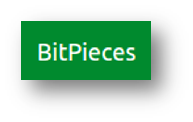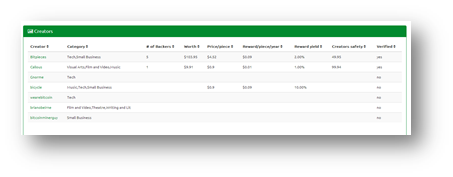Crowdfunding Your Project with BitPieces: A Talk with Tyler Houlihan
By Mark Norton: Editor @ BitcoinWarrior.net
According to the Small Business Administration, about 600,000 new businesses are started just in the US each year. Each one of these businesses represents the hopes and dreams of the person or people founding it, and often represents people who are putting themselves far out on a limb financially and emotionally to get that business going. Every one of them is hoping to get a little bit of help.
Unfortunately, that help is scarce: according to the same reports, only about 300 startups each year will get VC funding. This means that less than one percent of any venture will get external funding and support.
Crowdfunding sites like KickStarter and Indiegogo have risen to address just this issue. They give small entrepreneurs a way to get funding without having to find an angel investor who will provide a  large lump-sum, but instead find many people will put up just a little bit of money.
large lump-sum, but instead find many people will put up just a little bit of money.
Tyler Houlihan is one individual who has been innovating a new way to crowdfund using Bitcoin with a twist: Rather than getting a limited-edition product as a reward, Tyler’s BitPieces site promises continuing and automatic dividends based on the rising popularity of the brands funded.
As is often said, Bitcoin is still in its early days when the space for creativity and innovation are wide open. I tracked Tyler down to ask him a few questions about his new site.
So to start this off, could you tell me a little about yourself: What your history is and how you got involved in the Bitcoin economy?
I’m a software dev with experience in the financial services field, but I’m highly interested in Bitcoin and dividend stocks. I created the site to help solve the fundamental problem of how people with great ideas can get funding, anywhere in the world, without having to promise some ‘product,’ to funders at some specified date. Really, what we’re talking about here is a stock market, and despite all the exchanges that are out there, no real stock market involving Bitcoin has been made yet – until now. That, along with the idea that dividends should be easy, automatic, continuous, and transparent in order to establish a history of trust, is what led me to build the site.
When someone creates a project, they sell off ‘pieces,’ or shares, of the project. These shares are paid rewards on a regular basis at a rate set by the creator. You recommend that it be something like 1-2 percent. There are already a number of crypto and non-crypto micro-funding sites out there. What gave you the idea for this and what problem do you solve that  the others don’t?
the others don’t?
Some things that differentiates Bitpieces from other crypto and micro-funding sites:
- BitPieces is entirely open-source and hosted on GitHub.
- The rewards that are paid to funders are automatic and continuous. Once you buy the shares, you just watch the rewards grow in your account.
- While BTC is used for all transactions, everything from historical charts to current value of everything traded can be displayed in your local currency (I think we’re up to around 20 currencies right now).
- BitPieces is a clean, bootstrapped interface with highly interactive charts.
The micro-funding sites that I know of function more like lenders or bond issuers. BitPieces is more equivalent to stocks, where you are buying equity.
So again, from my understanding, when the creator starts a project, he or she creates a number of pieces to be sold – so there will be a fixed amount of them. Anyone who purchases one of those pieces potentially gets rewarded in two ways: First, as we said, their shareholdings increase according to a schedule set when the project is created, and also, since the pieces are tradable, through an increase in the exchange rate of the pieces. That means that if a project is a hit, then the price of the pieces might skyrocket, netting the investor a huge profit off their initial investment. Is that right?
Yes. For all intents and purposes, you can think of pieces as stocks. Once all the initial pieces are sold, then the bidding and valuation game can start: if people think the pieces are worth more, then they can bid higher on them and the sellers or askers can ask more for them. If the project is a hit, the price of the pieces will go up because people are willing to pay more for them. So just like stocks, these kind of speculative games start out. But this isn’t just pure speculation on some exchange rate, it’s people valuing how much they think a brand or creator is worth. If a web-comic sells pieces, it’s up to everyday people to decide how much that work is worth and how much they’d like to be a part of fueling its growth.
This actually sounds a little bit like colored coins. What’s the difference between a colored coin and a piece?
For one, colored coins, with dividends or rewards, as far as I know, are at a very early stage. If they were easy to use, or better developed, you’d see a lot of content creators using them. Secondly, people want a centralized place to go to do their funding, like Kickstarter or even exchanges. What happens, then, is you tend to see crowdfunding platforms being created as walled-gardens. This makes them very easy for funders to use and the funds raised generally stay within that framework. BitPieces is no different. The marketplace, the process which compares the bids and asks, and the system that gives you rewards, are all internal. Hopefully, the interface is clean enough, and it’s easy enough to use that people will enjoy it.
Once these colored-coins and other systems become more popular, streamlined, and easy-to-use, we will be looking for ways to integrate them with our system.
Where will people be able to store their pieces? Will they be able to store or exchange them privately, or will all trades need to be done on the BitPieces site? How is security handled for pieces?
You do actually own the pieces that you buy, and you do have complete control over them; you just currently can’t transact them outside the website. Charts like these would be impossible if it were possible to sell pieces outside the network.
https://bitpieces.com/creators/pieces/Bitpieces
https://bitpieces.com/users/overview/testuser
There’d be no way for them to accrue rewards or to display trades if the site couldn’t track who owned them or when they were sold. That being said, the  rewards you accrue can be withdrawn at any time and every action of a creator or user is entirely transparent.
rewards you accrue can be withdrawn at any time and every action of a creator or user is entirely transparent.
As for security, the only way to transfer pieces, currently, is through the site, which is very secure: SSL, secure backends, no storing of passwords, and jasypt encryption, ensure that logging in and using the site is safe.
From a funder’s perspective, I really get what the potential benefits of this might be, and also some of the risks. You set up a five-pillar trust system. Could you tell my readers something about how that works?
Fraud prevention is a huge topic so I really wanted to make something as fraud-proof as possible. Even when people are very careful with their investments, fraudsters can get pretty far. It’s really important for the funders to feel that they can fund projects with confidence, assured of the safety of their investment
With a site like BitPieces, this is especially difficult because the creators aren’t IRS-accredited – they are just content creators. Valuing what they create can be a hazy process (kind of like deciding how much a bitcoin is worth). In my opinion, stopping fraud is all about transparency, verification, and an ability to pay rewards consistently. Paying rewards on past and current projects shows that the creator is willing to give something back to the people that helped fund them. The 5 safety measures BitPieces has instituted are:
- Creator verification
- Creator safety ratings
- Mandatory rewards
- Open discussion threads
- Transparency
https://bitpieces.com/FAQ#how_do_i_know_if_a_creator_is_safe
Now, of course, if a project fails or the creator disappears, then the funders are out of their money. As much as you might try to create systems to prevent this, it’s also the nature of the game. I did get a little confused about how this works for the creators, though. When funding from a project starts coming in, creators will start repaying immediately according to a schedule that they advertise on their project page. Presumably they use some of the funds raised to buy some of their own project in order to have enough pieces on hand to start paying the investors. Part of your trust system is based on how many pieces they have in reserves to pay back the funders. When they need to replenish that supply, do they need to buy shares of their project back from their investors? If this is the case, then if their project is a sudden hit, the cost of purchasing those pieces might become prohibitive. Am I missing something here?
This is a good question: What if a creator goes bust?
Well, first let’s break it down into two categories: Honest creators, and dishonest creators.
This is a major reason why creator verification is so important. An unverified creator has no reason to keep their funders happy. But a verified content-creator has to answer for their actions to the people funding them.
There’s a number of ways an honest creator who’s going bust can handle it:
- If they’re having a financially tough time, they can decrease their reward to a very tiny amount. However, if they decrease the reward to their funders, there will be little point to owning their pieces. This still does leave open the possibility of them increasing the reward again in the future. Note that if the price of a project’s pieces fall to a certain level, this will happen automatically.
- If they’re giving up their brand entirely, they can buy back their pieces from the funders. Creators would do this in order to keep up the trust and good-will of the funders. This will be really easy to do on the system: the can just send a message to the funders or post on the discussion thread that they are shutting down, request how much the funders bought the pieces for, and buy them back.
To me, there are two types of dishonest creators: the type posing as someone they’re not and the type that just lies about their project.
First we need to weed out the first type by prominently displaying creator verification.
Solar roadways on Indiegogo, or Enron are in the second category and are pretty hard to stop. Personally, I think it’s better to err on the side of freedom. Rather than centrally shutting projects down willy-nilly because they might appear to be fraudulent, it’s to best to expect funders to do research on what these people make and make sure they’re paying a good reward for what you think they’re worth.
My first impression is that this service would really be better for people just getting started out and other smaller projects rather than really big ones. Do you see yourself catering to more of an ‘indie’ crowd or do you think that BitPieces is also suitable for really big projects?
The problem I was trying to solve is to help small projects get funding, but I don’t see why big names couldn’t sell pieces of their brand to funders. If XKCD or a band I like, like Tokyo Police Club decided that they want to let fans become their owners, I see no reason why they shouldn’t.
You say that one of the motivations behind this project is to make the opportunity to fund projects like this truly international. People can invest in 20 different currencies. What are they?
All the actual transactions are done in BTC, using Coinbase as a processor. Everything can be displayed in one of twenty currencies:
BTC, AUD, BRL, CAD,CHF, CNY, EUR, GBP, HKD, IDR, ILS, MXN, NOK, NZD, PLN, RON, RUB, SEK, SGD, TRY, USD, ZAR
I think it’s important to show valuation in local currencies since, although I’m a Bitcoin fanatic, I still think of prices in my own currency, the US dollar. Still, I don’t see anything wrong with using BTC as a kind of international second language for commerce.
I noticed that you’re funding BitPieces on BitPieces. How can people get involved?
The best way people can get involved is to spread the word and find some creators that would want to make pages and sign up. Inspired by tip4commit, I lowered the withdrawal fees on creators to just 1%, which is much less than Kickstarter’s 5% fee for creators.
As far as the BitPieces project itself, I want this to be one of the first crowd-sourced companies with funders being the driving force behind its development. That’s why everything is open-source hosted on GitHub and why I want to reward my funders. If you feel that it’s a good idea, and you feel comfortable owning pieces of it, and you want to help me devote more time and effort to it, then I’d love to have you own some pieces.
Currently it’s just me working on it, but I’m interested in hiring a team, a few more devs, some marketing people, legal people, etc. BitPieces will ALWAYS stay entirely open-source, but there’s still plenty of work to be done.

